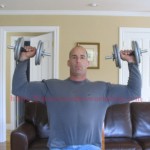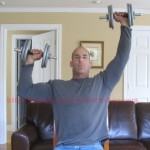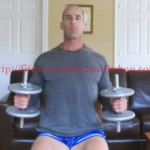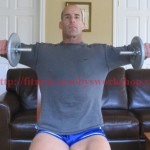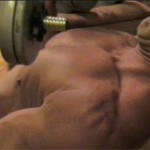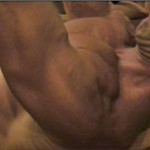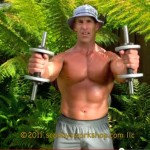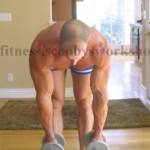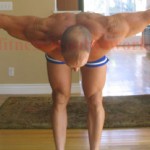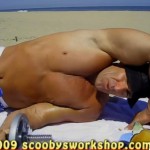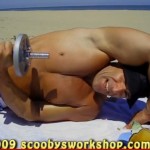Shoulder Exercises
Unlike most muscles, broad shoulders show even when you are fully clothed! If you want that sought after V-taper, working on shoulders is very important. Just a warning, the shoulder has very small muscles and the joint itself can be injured very easily so you really need to watch your form when doing shoulders. All the time you see people doing these shoulder exercises with really heavy weights but they cheat so much that you wonder if they are doing a leg workout or a shoulder workout. Many of these exercises are best done seated to remove the temptation of using the legs to bounce the weights up. Important on all these exercises is to keep your elbows and hands in front of the plane of your body, your shoulder is very unstable and prone to injury if you hyperextend it behind your torso. In all these exercises the shoulders are held all the way down and back like you are trying to hold a tennis ball between your shoulder blades – this makes the shoulder stronger and less prone to injury. There are many exercises here, probably more than you have time for in one session so just choose different ones each week. I have broken these exercises down into shoulder
 |
Shoulder Mass Builders
Alternating Dumbbell Press
The dumbbell press and the alternating dumbbell press are great shoulder mass builders you can easily do at home. Above I am showing an alternating dumbbell shoulder press but you can do them simultaneously using these same instructions. Many people make the mistake of leaning back when they do the dumbbell shoulder press, for this reason I recommend using a stool or bench rather than something with a back rest. Although you can do a lot more weight if you lean back slightly, that ends up being an incline press which works your chest more than the shoulder. For more on this subject you can watch my video on bench press, incline press and military press. Again, dont lean back!
starting position: Seated on a backless bench, keep your abs flexed to support your lower back, and keep your shoulders down and back like you are trying to hold a tennis ball between your shoulder blades. Lift the weights up so that your elbows are the same height as your shoulders, make a note of this position because you wont ever go lower than this. Going lower puts a lot of strain on your shoulder joint and doesnt give you any additional benefit.
ending position: While keeping one arm motionless, lift the other arm slowly up on a 2 second count till it is straight but not locked. Dont spin the weight, keep your palms facing away from you during the whole exercise. Now lower it back slowly down to the starting position. Now repeat this with the other arm! If you find you cant lift the weights this slowly, then you are using too much weight!
Straight Arm Side Raise
Dont just do military press and dumbbell press for shoulders! The side raise really helps pack on the mass too and I love the way the side raise feels. You can do these standing or seated on a flat bench. Although you can do this exercise with your elbows bent 90 degrees as the exercise below illustrates, this straight arm version I show here wont cause elbow tendonitis.
starting position: Abs tight to support the lower back, shoulders down and back, dumbbells hanging at your side with your thumbs pointed outward. You mouth does not need to be open as I illustrate in this photo :)
ending position: Slowly raise the weights up over a one-one thousand, two one-thousand count while keeping the shoulders down and back. Dont spin them as you raise them. At the top of the movement your thumbs should point upward and your arms should be horizontal. Do not go further up, it can cause impingement in the shoulder and it doesnt give you any more benefit. More ROM (Range Of Motion) is not always better!
Bent Arm Side Raise
This is very similar to the above exercise but is done with the elbows bent 90 degrees. If you are prone to tennis elbow, skip this exercise and do the straight arm version above.
starting position: Abs tight to support the lower back, shoulders down and back, elbows bent 90 degrees with thumbs pointed up.
ending position: Slowly raise the weights up over a one-one thousand, two one-thousand count while keeping the shoulders down and back. Dont spin them as you raise them. At the top of the movement your thumbs should point inward toward each other and your upper arms should be horizontal. Do not go further up, it can cause impingement in the shoulder and it doesnt give you any more benefit. More ROM (Range Of Motion) is not always better!
Front Press (Incline or Seated)
The front press is a great exercise that is similar to the alternating dumbbell press. If other shoulder presses hurt your shoulder joint, give this one a try! This exercise not only works the shoulder but the pecs as well. This exercise can be done seated or on an incline bench as I show here. Here is a video showing how to do the incline front press and its upright variant, the seated front press. The main characteristic that differentiates this exercise from military press and the dumbbell shoulder press is that in this exercise the elbows stay in close to the torso rather than being out to the side like you are trying to air out your armpits.
starting position: Abs tight to support the lower back, shoulders down and back, elbows touching your sides, thumbs pointed toward your head. Before you start, notice how far the weights are apart, thats how far they will be apart while you lift them.
ending position: Slowly push the weight up over a 2 second count, dont let the elbows drift apart – keep those weights the proper distance apart. Then slowly lower the weights till your elbows touch your sides again. Don’t let your elbows go lower than that, it stresses the shoulder joint and doesn’t give you any additional benefit.
Straight Arm Front Raise
Above I mentioned about how important the side raise is in building big shoulders. Now lets talk about the front raise. Now, one would think that if the side raise is good for building big shoulders, the front raise would be too – right? Wrong! Its a great exercise but its not really for shoulders – its arms, chest, and shoulders. You can do these standing or seated but if you stand, make sure you dont bounce with your knees! Shoulders are down and back, hold them like that the whole exercise. For any shoulder exercise its important to hold that position.
starting position: Abs tight to support the lower back, shoulders down and back, arms straight but not locked, thumbs pointing frontwards.
ending position: Slowly lift up to horizontal over a 2 second count with the thumbs up. Dont go higher than horizontal, too easy to impinge. If you cant do them this slowly then you are using too much weight. Slowly lower the weights down to the starting position.
Stabilizing Exercises For Shoulders
The shoulder has some really small stabilizing muscles that are very important to keep strong because it can help prevent injury. These exercises are also used sometimes in the rehabilitation of rotator cuff injuries. Working out these muscles will not add any mass you will see when you step on a scale and you wont see them at the beach either but they are very worth doing to prevent injuries. Think of them as very cheap health insurance. Ask anyone who has a rotator cuff injury how devastating it has been to their lifting and it will convince you of the value of keeping strong stabilizing muscles. Remember, these stabilizing muscles are very small so you need to use small weights. This is a good time to leave your ego outside the weight room. Use too much weight on these and you are almost guaranteed to get an injury requiring expensive shoulder surgery to fix. Start out with 2 or 5lbs. Use a very light weight on this, its a small muscle group. Proper form is very important or you will hurt your shoulder or back. Only your arms move, your legs, head and torso remain completely motionless – if you have to bounce then you are using way too much weight. In all these exercises, no pain is acceptable – stop immediately if you feel pain and either lower the weight till its pain free or see a doctor.
If you have a shoulder injury and are doing rehabilitation exercises, I recommend you do these with a resistance band rather than weights as shown below.
Reverse Flys
If you have a really tall bench, you can do this face down on the bench as long as the dumbbells dont touch the ground in the down position, otherwise do them standing. I often find it helpful to keep my head very lightly touching a chair or some other object just so I can be sure that my head is not moving up and down. Only the arms move in this exercise, the rest of the body is completely motionless – including the torso. When you are bent over, make sure to keep your abs flexed tight to support your lower back! Start with a really light weight when you first try this exercise, try 5lbs to start and only move up when you can completely control the weight.
starting position: Abs tight to support the lower back, torso horizontal, arms hanging down, thumbs pointed up toward your head, shoulders down and back like you are trying to hold a tennis ball between your shoulder blades. Don’t arch your back like a hissing cat and don’t sag your back like a banana.
ending position: Slowly lift the weights up taking 2 complete seconds to get the weights up. Keep your arms out straight at a 90 degree angle from your body, if you have to sweep your hands back like the wings of a 747 then the weight is too heavy for you. Stop when your arms are horizontal, going further up would risk shoulder injury and not provide any additional benefit anyway. When you get to the top position, hold it for “one one-thousand” before lowering it back down. Don’t bob your head up and down, jump with your legs, or swing the weights. If you have to do any of these things then you are using WAY too much weight.
Outer Shoulder Rotations
I know I already harped on this but I need to mention it again – do really light weights when you do these stabilizing exercises! The muscles are small and you could easily do some serious damage by using too much weight. Starting with 2 pounds is probably a good idea, only move up if its way too easy. This exercise is best done one the ground, doing it on a bench can allow too large a range of motion and could cause injury.
starting position: Lay on your side and put a folded towel between your elbow and your side. Your elbow will stay pinned against your side the entire duration of the exercise. Keep your shoulder down and back, dont let it roll forward. Grasp the dumbbell and keep it horizontal as you start lifting …
ending position: Lift the dumbbell slowly over a two second count till it is the same height as your shoulder, dont go higher! Keep your elbow bent 90 degrees and keep the elbow pinned to your side. If you cant lift the weight slowly then you are using too much weight.
Inner Shoulder Rotations
I know I already harped on this but I need to mention it again – do really light weights when you do these stabilizing exercises! The muscles are small and you could easily do some serious damage by using too much weight. Starting with 2 pounds is probably a good idea, only move up if its way too easy. This exercise is best done one the ground, doing it on a bench can allow too large a range of motion and could cause injury.
starting position: Lay on your side with your elbow pinned at your side under your body. Your free arm can be left at your side or flopped over your head as I illustrate here. Keep your shoulder down and back, dont let it roll forward. Grasp the dumbbell and keep it horizontal as you start lifting …
ending position: Lift the dumbbell slowly over a two second count till it is as high as you can go. Keep your elbow bent 90 degrees and keep the elbow pinned to your side. If you cant lift the weight slowly then you are using too much weight.
Dumbbell Shrugs
Although not a shoulder exericse, I include them here because many people do traps with shoulders. Dumbbell shrugs are my favorite trap exercise. You need to do these on a narrow footstool or bench, do not do them standing as the temptation to cheat with the legs is too great. Several key points on the dumbbell shrug. First, keep your shoulders held back like you are trying to hold a tennis ball between your shoulderblades – hold this position the entire duration of the exercise. No rolling the shoulders forward as many people do! Second key point, choose an elbow angle and hold that the entire duration. Dont turn this exercise into a dumbbell curl! Many people do WAY too much weight on this exercise and turn it into a whole body workout, this is for traps only so lower the weight!
starting position: Shoulders held back with your chest thrust out. Sholders as low as you can go in this position. Arms straight but not locked.
ending position: Slowly shrug your shoulders while continuing to hold your shoulders back with your chest thrust out. Dont bend your elbows, keep your arms straight but not locked. Slowly raise your shoulders up on a two second count. If you cant shrug with this form then you are using too much weight.

